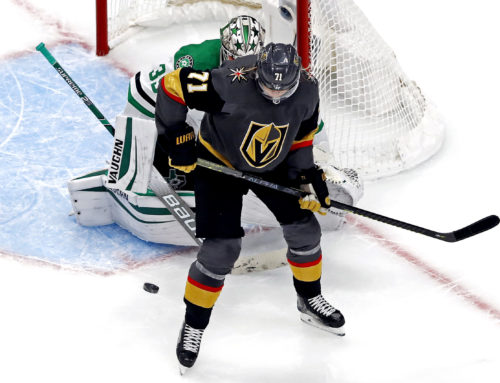Frozen Tools Forensics: How predictable are game-winning goals?
Chris Kane
2020-05-08
The Big Board report is a treasure trove of useful information. This week I was scanning over the columns represented and game winning goals (GWGs) caught my eye (mostly because Leon Draisaitl has 11 on a shortened season and was at the top of the list). GWGs are a bit of an enigma. They are usually a very small sample, seem hard to repeat, and impossible to predict. Playing mostly categories leagues, GWGs are very frustrating and very random. In points leagues though the little extra credit for the game winner adds some excitement to the moment. So this week:
Game Winning Goals: Enigma or Just a Small Sample Size?
To look at this we start with the Big Board report. We have used it before, but as a quick refresher once exported it looks a little something like this (with a bunch of more columns that won't fit well here).
| Name | Pos | Age | Team | PTS | GP | G | A | GWG | PPP | PPTOI | %PP | TOI | SOG | |
| 1 | LEON DRAISAITL | C | 24 | EDM | 110 | 71 | 43 | 67 | 11 | 44 | 3:51 | 87.1 | 22:37 | 218 |
| 2 | CONNOR MCDAVID | C | 23 | EDM | 97 | 64 | 34 | 63 | 7 | 43 | 3:53 | 87.3 | 21:52 | 212 |
| 3 | ARTEMI PANARIN | L | 28 | NYR | 95 | 69 | 32 | 63 | 4 | 24 | 3:44 | 70.8 | 20:36 | 209 |
| 4 | DAVID PASTRNAK | R | 23 | BOS | 95 | 70 | 48 | 47 | 10 | 38 | 3:46 | 73.1 | 18:58 | 279 |
| 5 | NATHAN MACKINNON | C | 24 | COL | 93 | 69 | 35 | 58 | 4 | 31 | 4:07 | 73.3 | 21:13 | 318 |
For the purposes of this discussion we will be looking at columns that seem like they might have something to do with GWGs. The plan is to look for correlations between GWGs and other categories and see if there is anything that stands out or might be helpful. To start though let's analyze what a GWG is. At its most basic it is the goal a team scores that put them in the lead for the last time. That means it is first a foremost a goal (and therefore a shot), and secondly a goal that has some context. What makes it tricky is that GWGs can happen at any time in the game and aren't necessarily the exciting overtime play we might naturally think they are. It can be the fluke goal scored in the first period of a 7-0 drubbing. But every game (that doesn't go to a shootout) has a GWG. With that in mind let's dive into some stats and see if we can see any interesting correlations.
The most obvious place to start is total goals. This one is straight forward, a GWG is at its most basic a goal so someone with more goals has more chances at a GWG. If we remove some columns from our Big Board Report and sort by GWG we get the following top ten.
| Name | Pos | GWG | G | |
| 1 | LEON DRAISAITL | C | 11 | 43 |
| 2 | DAVID PASTRNAK | R | 10 | 48 |
| 3 | JACK EICHEL | C | 10 | 36 |
| 4 | DAVID PERRON | L | 10 | 25 |
| 5 | KYLE CONNOR | L | 8 | 38 |
| 6 | ANDREI SVECHNIKOV | R | 8 | 24 |
| 7 | CONNOR MCDAVID | C | 7 | 34 |
| 8 | MIKA ZIBANEJAD | C | 7 | 41 |
| 9 | STEVEN STAMKOS | C | 7 | 29 |
| 10 | JONATHAN TOEWS | C | 7 | 18 |
In a quick scan we see that we have a lot of top goal scorers in the top ten of GWGs. It isn't a perfect fit though Jonathan Toews only has 18 goals and seven of them are GWG. On the flip side Austin Matthews has 47 goals but doesn't make the list. In order to really test the correlation though we need to hope over to Stats 101 for a minute and talk about r^2. Basically it is a function that lets us talk about how closely related two data sets are. A score of 1.0 would mean a perfect match, a 0.0 means absolutely nothing in common.
Our goals to GWG relationship is .671. That means basic goal numbers have a pretty strong correlation to GWG (and this makes sense given what we know about GWG), but it certainly doesn't account for everything. As a point of comparison comparing shot totals to GWG gives us a r^2 of .488. That means shot numbers are less correlated to GWG numbers than total goals. This makes a ton of sense. Shots is a great predictor of goals (r^2=.742), but not every goal is a GWG so shots is another step removed from the outcome here.
What ways can we account for the missing correlation though? There are a bunch of other factors to consider. A traditional view of GWGs would be that players with high GWG numbers are clutch players put in at the end of the game or in overtime to put the team over the edge. We already looked at goals, but what about players that coaches trust a lot and so might be put in at crunch time? What is the comparison to players who have high time on ice, or a lot of power-play time?
It turns out that total time on ice does not have a strong correlation (r^2=.151). Again, it makes sense. There are a ton of situations where a player can rack up minutes that are not high priority offensive minutes (short-handed time being a prime example). So how can we approximate a coach using a player in offensive situations?
Power-play time is one possible solution and presents a fairly strong case as it is reasonably correlated (r^.408). This doesn't necessarily tell us that this coaching decision is really related to GWGs, maybe they just score more goals because they are on the power play and because they score more goals they end up with more GWG.
Another way to look at this might be, who does a coach put into positions to score? Offensive Zone starts is a metric that measures the percent of time a player is started in the offensive zone versus the other zones. Spoiler alert, there is almost no correlation between zone starts and GWG (r^2=.0002). Thinking again about the stat, this result does make sense too. A lot of a player's starts are on the fly and not at a face-off and often players with better offensive zone starts are not trusted as much by the coach so might not be put in as many situations to get high goal totals.
So what have we learned so far? Well unsurprisingly the strongest correlation exists between goal totals and GWGs. Shots and power-play time come in second. Shots likely because they lead to goals generally. The same is also true of power-play time, but it does also get to the coaches discretion piece, which can certainly impact the high stakes GWGs we love to watch.
Which leads us to the final question. Is this a repeatable skill? It is such a small sample do we see players consistently performing it at a high level? A quick (and non-exhaustive) comparison to 2018-19 suggests maybe not.
| 2018-19 | 2019-20 | |||||
| Name | Pos | GWG | Name | Pos | GWG | |
| 1 | PHIL KESSEL | R | 11 | LEON DRAISAITL | C | 11 |
| 2 | CONNOR MCDAVID | C | 9 | DAVID PASTRNAK | R | 10 |
| 3 | BRAD MARCHAND | L | 9 | JACK EICHEL | C | 10 |
| 4 | ARTEMI PANARIN | L | 9 | DAVID PERRON | L | 10 |
| 5 | TYLER SEGUIN | C | 9 | KYLE CONNOR | L | 8 |
| 6 | GABRIEL LANDESKOG | L | 9 | ANDREI SVECHNIKOV | R | 8 |
| 7 | CAM ATKINSON | R | 9 | CONNOR MCDAVID | C | 7 |
| 8 | ELIAS PETTERSSON | C | 9 | MIKA ZIBANEJAD | C | 7 |
| 9 | NIKITA KUCHEROV | R | 8 | STEVEN STAMKOS | C | 7 |
| 10 | JOHNNY GAUDREAU | L | 8 | JONATHAN TOEWS | C | 7 |
In the above table we look at the top ten GWG scorers in 2018-19 and 2019-20. There is only one name on both list, Connor McDavid. In comparison there is a 40% overlap with players in the top ten in goal totals between the two years, and higher if you extend to the top 15.
At the end of the day it appears that GWG is repeatable in the sense that players who score high numbers of goals are going to do better in the category, but that there is enough chance at play here that they carry over from season to season is incredibly small and hard to predict.
That is all for this week. Thanks for reading.
Stay safe out there.
Want more tool talk? Check out these recent Frozen Tool Forensics Posts.
Frozen Tools Forensics: Scoring Wars – Young Guns and the Old Guard
Frozen Tools Forensics: Power-play production and Alex Ovechkin
Frozen Tools Forensics: 2020-21 Breakout Candidates Part 2





 DAL
DAL VGK
VGK EDM
EDM L.A
L.A T.B
T.B BOS
BOS TOR
TOR VAN
VAN NSH
NSH NYI
NYI CBJ
CBJ
